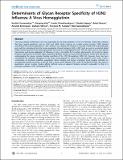Determinants of Glycan Receptor Specificity of H2N2 Influenza A Virus Hemagglutinin
Author(s)
Viswanathan, Karthik; Koh, Xiaoying; Chandrasekaran, Aarthi; Pappas, Claudia; Raman, Rahul; Srinivasan, Aravind; Tumpey, Terrence M.; Sasisekharan, Ram; Shriver, Zachary H.; ... Show more Show less
DownloadViswanathan-2010-Determinants of Glycan Receptor Specificity of H2N2 Influenza A Virus Hemagglutinin.pdf (758.5Kb)
PUBLISHER_CC
Publisher with Creative Commons License
Creative Commons Attribution
Terms of use
Metadata
Show full item recordAbstract
The H2N2 subtype of influenza A virus was responsible for the Asian pandemic of 1957-58. However, unlike other subtypes that have caused pandemics such as H1N1 and H3N2, which continue to circulate among humans, H2N2 stopped circulating in the human population in 1968. Strains of H2 subtype still continue to circulate in birds and occasionally pigs and could be reintroduced into the human population through antigenic drift or shift. Such an event is a potential global health concern because of the waning population immunity to H2 hemagglutinin (HA). The first step in such a cross-species transmission and human adaptation of influenza A virus is the ability for its surface glycoprotein HA to bind to glycan receptors expressed in the human upper respiratory epithelia. Recent structural and biochemical studies have focused on understanding the glycan receptor binding specificity of the 1957-58 pandemic H2N2 HA. However, there has been considerable HA sequence divergence in the recent avian-adapted H2 strains from the pandemic H2N2 strain. Using a combination of structural modeling, quantitative glycan binding and human respiratory tissue binding methods, we systematically identify mutations in the HA from a recent avian-adapted H2N2 strain (A/Chicken/PA/2004) that make its quantitative glycan receptor binding affinity (defined using an apparent binding constant) comparable to that of a prototypic pandemic H2N2 (A/Albany/6/58) HA.
Date issued
2010-10Department
Harvard University--MIT Division of Health Sciences and Technology; Massachusetts Institute of Technology. Department of Biological Engineering; Singapore-MIT Alliance in Research and Technology (SMART); Koch Institute for Integrative Cancer Research at MITJournal
PLoS ONE
Publisher
Public Library of Science
Citation
Viswanathan, Karthik et al. “Determinants of Glycan Receptor Specificity of H2N2 Influenza A Virus Hemagglutinin.” Ed. Man-Seong Park. PLoS ONE 5.10 (2010) : e13768.
Version: Final published version
ISSN
1932-6203